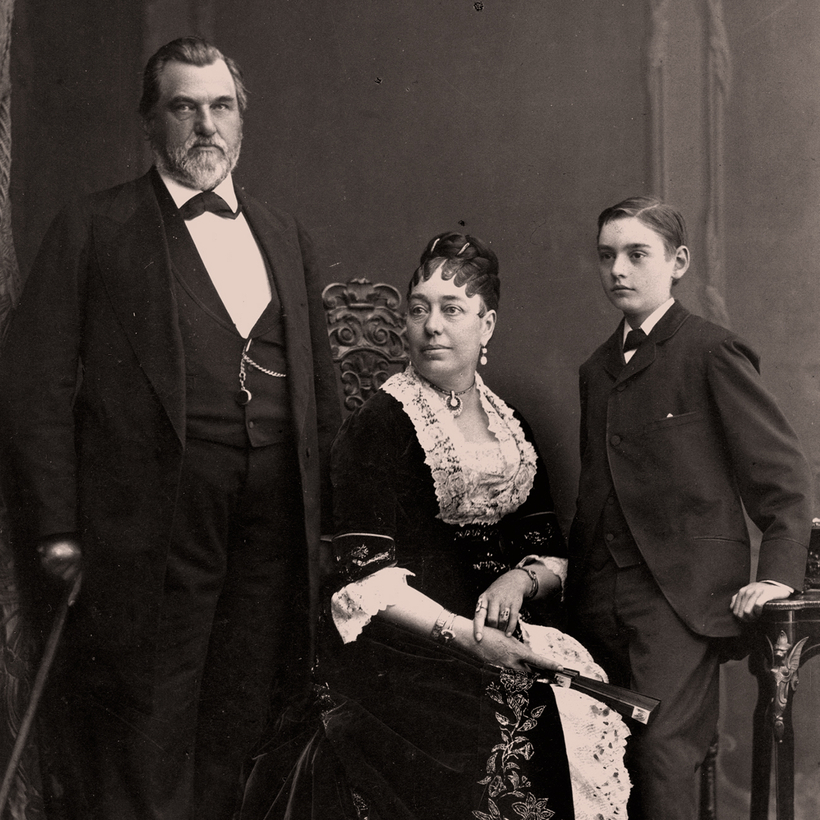The Stanford Mausoleum lies a few steps off of Palm Drive, the majestic roadway designed by Frederick Law Olmsted that leads to the university’s main quad. Tucked behind eucalyptus trees and a cactus garden, the mausoleum is among the more obscure attractions on campus and by far the weirdest. I visited it as a freshman, to attend the dance party held there every Halloween, and never went back.
Like most Stanford students, I was vaguely aware that the crypt held the remains of Leland Stanford Jr., after whom the school is named, and his parents, Leland and Jane Stanford. What none of us knew is that the mausoleum also concealed a dark secret: that Jane Stanford, who outlived her son and husband, didn’t die of natural causes in Honolulu on February 28, 1905, as the inscription on her tomb suggests. She was murdered.
In Who Killed Jane Stanford?: Murder, Deceit, Spirits, and the Birth of a University, historian Richard White excavates the story of Stanford’s final days and the extraordinary ways in which powerful figures close to her sought to undermine, discredit, and ultimately silence the investigation into her death.
Combining a prosecutor’s zeal for uncovering evidence with a crime novelist’s flair for suspense, White shows that Stanford died from ingesting strychnine, a form of rat poison. Exactly who gave her the lethal dose is the book’s central mystery, but far from its only revelation. The unsolved murder of the college’s founding matriarch, it turns out, is integral to understanding how Stanford eventually became one of the world’s great universities. In White’s words, “it was Jane Stanford’s death that saved the university created by the death of Leland Jr.”
Crack of Doom
The school was born in tragedy. Grief-stricken after the death of their only child, 15-year-old Leland junior, the Stanfords resolved to use their wealth to create a university in his memory, on a patch of farmland 35 miles south of San Francisco.

A corpulent robber baron, former governor of California, and U.S. senator, Leland Stanford was “not an educated man, nor did he know much about education.” He claimed that his dead son appeared to him in a dream, urging him to “live for humanity,” which meant making the new school a “place to send boys out to do missionary work.” To skeptics, the university seemed primarily a “giant exercise in money laundering,” built to allow the Stanfords to avoid paying taxes on their fortune.
When Leland Stanford died, in 1893, just two years after the university opened its doors, there was ample reason to believe the fledgling experiment would collapse. It might well have, but for his indomitable widow, Jane, who “controlled the endowment, the school’s growth, its construction and its priorities.”
Jane Stanford clashed with David Starr Jordan, the university’s first president and a promoter of eugenics. Jordan wanted to use Stanford’s money to build a modern research university to rival the Ivy League. Jane had other ideas. She pushed to limit the size of the student body, separate male and female students, and emphasize spiritualism; “the university’s essential task” was the “development of the soul.”
The power struggle between Jordan and Stanford turned the school into a hothouse of faculty feuds, scandals, and cover-ups. At the time of Jane Stanford’s death, Jordan had reason to believe he was about to be fired.
Did that make him an accomplice to murder? White makes a compelling case for why Jordan and the university’s trustees would want to be rid of their overbearing benefactor. But there were other suspects who also had strong motives, including various members of her long-suffering household staff, who stood not only to be freed from Jane Stanford’s control but also to inherit some of her money.
White sifts through the evidence surrounding two poisonings suffered by Mrs. Stanford in 1905: the first on January 14, at her Nob Hill mansion, which she survived; and the second one six weeks later, during a stopover in Hawaii en route to Japan, which killed her. “This is a horrible death to die,” she said, as her body convulsed in spasms.
Just as Hawaiian officials and the press began uncovering signs of foul play, a team of private detectives hired by the Stanford family arrived on the scene, accompanied by Jordan, intent on quashing the murder theory. Jordan declared that Stanford’s death was the result of “her advanced age … [and] a surfeit of unsuitable food.” That was enough to convince San Francisco’s police to call off their own probe. Reporters and the public soon lost interest. The mystery is only solved—satisfactorily, if not definitively—in the final pages of White’s book.
The story has a final twist. By suppressing the investigation into Jane Stanford’s death, Jordan and his allies successfully avoided any legal scrutiny that might have delayed or blocked the bequest of her estate to the university. Those funds almost certainly helped it survive the financial and physical ruin caused by the 1906 earthquake, which also destroyed the records of the murder investigation.
It’s little wonder that “David Starr Jordan never voiced any regrets.” Though Jordan’s name has been erased from all campus buildings because of his writings on eugenics, his vision for the school has prevailed. As for Jane Stanford, she would have been as shocked by the university’s transformation as by the sight of undergraduates dancing on her grave. But even she might have conceded it was worth it.

Romesh Ratnesar is on the editorial board for Bloomberg Opinion


